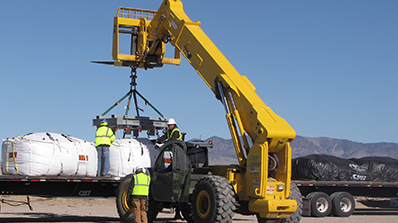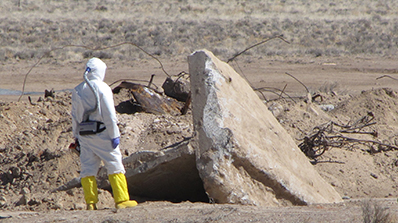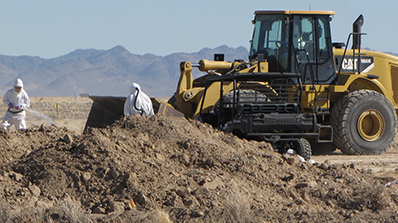A focus on safety through planning and communication is driving cleanup activities at the Clean Slate sites on the Tonopah Test Range (TTR), just north of the Nevada National Security Site (NNSS). This summer, cleanup activities will be completed at the Clean Slate II site and work will begin at the Clean Slate III site. Remediation of both sites involves the excavation, packaging and disposal of contaminated soil and debris at the NNSS.
The Clean Slate sites were the location of experiments conducted in 1963 to test the safety of nuclear devices. Though these experiments did not result in a nuclear yield, they caused the dispersal of various surface contaminants, including plutonium and americium. Two previous cleanup campaigns occurred in the late 1990s and 2014 but excavation and removal of contaminated soil was delayed until future use of the sites and associated cleanup levels were determined.
Planning for this final phase of cleanup began in 2016 through close collaboration between the Department of Energy’s (DOE) Environmental Management (EM) Nevada Program; EM Nevada Program cleanup contractor, Navarro; State of Nevada Division of Environmental Protection (NDEP); the U.S. Air Force and Sandia National Laboratories (both conduct activities on the TTR); and the Nevada Site Specific Advisory Board (NSSAB).

Upon agreement of a path forward, the EM Nevada Program focused on informing local communities about upcoming fieldwork. Throughout May and June 2017, briefings were provided and questions answered at meetings in Goldfield, Tonopah, Pahrump, Beatty, and Las Vegas. “Our commitment to sharing information and listening to feedback supports the building of trust within our neighboring communities,” said Rob Boehlecke, EM Nevada Program Manager.
To broaden public awareness, a fact sheet was published on the NNSS website and hundreds of copies distributed to intergovernmental groups; the Timbisha Shoshone Tribe; and libraries, senior centers, community organizations, and post offices in Tonopah, Goldfield and Beatty – rural communities that waste shipments travel through to the NNSS.
While community engagement efforts were taking place, preparations were finalized for field activities with an emphasis on safety. After successfully demonstrating readiness, the skilled and experienced crew proceeded with excavation and packaging of contaminated soil in November 2017. The first shipment of waste to the NNSS occurred in mid-December after coordinating with Nye County Emergency Management and the Nevada Department of Transportation to obtain and share information on routing.

Throughout remediation, coordination with Sandia and the U.S. Air Force continued, along with updates to the public. This included two Community Conversations events held in Tonopah.
In addition to ongoing communications, the safety of field activities continued to be evaluated and enhanced. Several safety initiatives were implemented, such as relocating equipment and activities to reduce heavy equipment operation and lessen worker fatigue. Management also collaborated with field workers to address unexpected oversized concrete debris found during excavation.
As remediation wraps up at Clean Slate II with the completion of an anticipated 170 shipments by the end of June, the focus on safety, communication, and experience will be carried forward to Clean Slate III. This summer, workers will begin excavating, removing, and packaging approximately 7,500 cubic yards of soil and debris. The effort is expected to continue into 2019 and involve an estimated 450 shipments planned in multi-week campaigns. The success of both cleanup and disposal campaigns have and continue to hinge upon the team’s commitment to safety and open and frequent communications.

